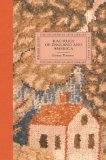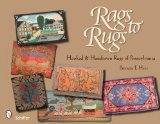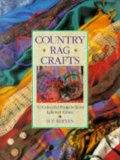-
History of:
- Resources about:
- More:
- Baby walkers
- Bakehouses
- Bed warmers
- Beer, ale mullers
- Besoms, broom-making
- Box, cabinet, and press beds
- Butter crocks, coolers
- Candle snuffers, tallow
- Clothes horses, airers
- Cooking on a peat fire
- Drying grounds
- Enamel cookware
- Fireplaces
- Irons for frills & ruffles
- Knitting sheaths, belts
- Laundry starch
- Log cabin beds
- Lye and chamber-lye
- Mangles
- Marseilles quilts
- Medieval beds
- Rag rugs
- Rushlights, dips & nips
- Straw mattresses
- Sugar cutters - nips & tongs
- Tablecloths
- Tinderboxes
- Washing bats and beetles
- Washing dollies
- List of all articles
Subscribe to RSS feed or get email updates.
As I sat stripping, stripping away,
Making my carpet of rags, to-day,
Shredding up garments all worn and old,
Which once had sheltered from heat and cold
The loves of the household, - in bygone time
When they were new, and in their prime, -
My thoughts were away with those vanished years,
Their loves and their labors, their hopes and fears.
I touched not a garment but brought to mind
Some pleasure, or pain, long left behind...
Frances Dana Gage, Rag-carpet Rhymes, 1867

Rag Rugs of England and America (Decorative Arts Library) from Amazon.comor from Amazon UK

Let us see how a careful settler's wife will contrive out of worn-out garments...to make a warm, durable, and very respectable covering for the floor of her log-parlour, staircase, and bedroom. " I asked the wife of the resident minister ...what she was going to do with a basket of faded, ragged clothes, old red flannel shirts, and pieces of all sorts and sizes, some old, some new, some linen and cotton, others woollen. ' I am going to tear and cut them up for making a rag-carpet,' she replied ... "' I will show you,' she said, ' what I am going to do with these things.' She then took a piece, and with the scissors began cutting it into long narrow strips....Instead of selecting her rags all of one shade for the ball, she would join all kinds of colours and materials. ' The more lively the contrast the better the carpet would look,' she said.... " If you double and twist the warp yourself, the weaver will charge 6d. [six pence or pennies] a yard for the weaving, but if he doubles and twists he charges 8d. ...When well assorted, I assure you, these rag-carpets make by no means a despicable appearance on the rough floors of a Canadian farmer's house.
Peter Lund Simmons writing in London about Canada in 1862 (Waste Products and Undeveloped Substances)

Order Rag Rugs: Hooked and Handsewn Rugs of Pennsylvania from Amazon.comor Amazon UK

Rag rugs, mats & carpets
Covering floors with woven, hooked, braided, prodded, or crocheted strips of cloth
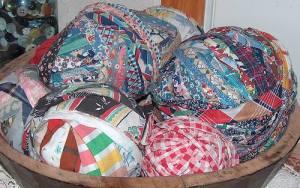 Sometimes it's hard to be precise
about the history and origins of simple domestic crafts and equipment. Writers weren't
usually interested in recording the details of everyday housekeeping and low-status
domestic crafts until the 19th century. Even then we have limited descriptions of
rag rug making before about 1900.
Sometimes it's hard to be precise
about the history and origins of simple domestic crafts and equipment. Writers weren't
usually interested in recording the details of everyday housekeeping and low-status
domestic crafts until the 19th century. Even then we have limited descriptions of
rag rug making before about 1900.
Many different cultures have found ways of recycling old bits of cloth into beautiful rugs, clothing and other items, but we know very little about the craft before 1800. Outside Asia the earliest rag floor coverings were probably woven from strips of cloth somewhere in Northern Europe, quite likely on a loom in Scandinavia where rug-making traditions are very strong. Even when we hear about old rugs, we have to remember it could be a bed-rug or coverlet. It's unclear when people started to think of them primarily as floor-mats, but dictionary citations suggest it was during the 19th century.
Not only do we not have much written evidence about the origins of rag rug-making, but there aren't any really old rugs of this kind surviving. They weren't precious textiles hung on a wall, and so they were used, worn out, and disposed of.
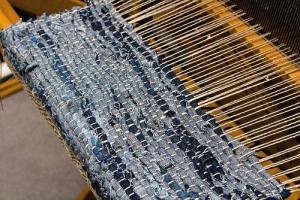 Rag rugs really took off in the 19th
century with machine production of cloth. Spinning and weaving were no longer hand
crafts, but industrial processes, and fabric was produced in much greater quantity
than before. The use of wood pulp instead of cotton rags for paper-making also helped
make more used clothing available for rug-making.
Rag rugs really took off in the 19th
century with machine production of cloth. Spinning and weaving were no longer hand
crafts, but industrial processes, and fabric was produced in much greater quantity
than before. The use of wood pulp instead of cotton rags for paper-making also helped
make more used clothing available for rug-making.
There certainly were floor coverings made of cloth scraps before industrialisation. One of the cheapest kinds of carpeting in the 18th century was "list carpet" woven from selvedges (called lists) and other leftovers. Just as in the picture (left) the rag strips were woven on a normal yarn warp.
The list carpeting known in both 18th century England and colonial America wasn't produced by home-makers. It was made by artisans for sale. Rag carpets made in a similar way were also used in American and Canadian homes in the early 1800s, but these depended on a lot of labour by pioneer and settler families.
In England nobody understands what rag-carpets are; but in every part of America they are more or less used. The wealthy use them for their kitchens, and sometimes dining rooms; the farmers, for their chambers; and often every room in the house will be covered with them ... Every conceivable kind of woollen cloth was cut into little shreds about half an inch wide, and an inch long. These were all joined together lengthwise, and then wound in balls. The children's employment was to help in sewing the shreds together, and thus to make hundreds and thousands of yards of woollen band. This was afterwards woven into a coarse kind of carpet, and produced a mottle of all colours, not at all unpleasing to the eye. Occasionally such carpets would be dyed all of one colour; sometimes they were woven into a regular pattern, stripe or plaid; but this...was to be a mottled one; and their young friends...were invited for a few days to help in this homely but curious work; during which, however, some amusing book was read, and thus the time passed pleasantly.
Mary Botham Howitt, Our Cousins in Ohio, 1849
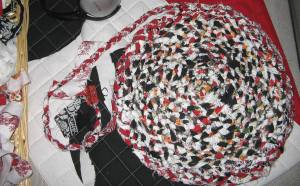 Descriptions from North America in
the first part of the 19th century show that in many areas rags were collected,
cut, sewn together, and wound into balls at home, and then sent away for weaving
by professionals who charged by the yard. (See quote lower down left-hand column.)
This seems like a half-way house between carpeting made entirely by full-time weavers
and the completely home-made rug.
Descriptions from North America in
the first part of the 19th century show that in many areas rags were collected,
cut, sewn together, and wound into balls at home, and then sent away for weaving
by professionals who charged by the yard. (See quote lower down left-hand column.)
This seems like a half-way house between carpeting made entirely by full-time weavers
and the completely home-made rug.
Another way of using sewn-together strips is to coil them round and stitch the coils together as you go. Braiding the strips adds strength and texture. (See photo right) You can also crochet or knit them together in ways that don't need stitching. (Crocheted rug from 1935 below left)
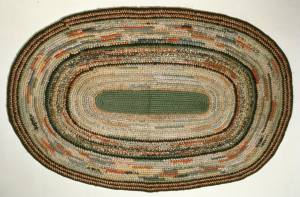 American county fairs and other
exhibitions in the 1800s often displayed rag rugs, and sometimes rag carpets
too. The rugs were always by women, the carpets often by men. Perhaps these men
were the weavers who took the rag balls laboriously prepared at home and transformed
them into cheap carpets?
American county fairs and other
exhibitions in the 1800s often displayed rag rugs, and sometimes rag carpets
too. The rugs were always by women, the carpets often by men. Perhaps these men
were the weavers who took the rag balls laboriously prepared at home and transformed
them into cheap carpets?
Supposing an old alpaca or mohair skirt to be the first thing to hand, it should be torn into strips..These strips are to be joined together slightly by needle and thread till a good length is obtained, said length to be folded down the centre...and the knitting commenced, the doubled strip of alpaca being used on the needles, precisely as a ply of wool or cotton would be. ..it is best to knit it in strips of the required length for carpet or cover...and join them together afterwards.
"Rag Knitting" in Yorkshire, described in 1865 magazine
Women had many ways of recycling old garments and scraps into rugs. Though it's rare to find a description of their work in print - records of fairs just tell us it was commended or won a small cash prize - we do occasionally find confirmation that women were using techniques other than weaving or coiling. In 1844, for example, one rug exhibited in Massachusetts had a "wreath of flowers on a blue ground" - not likely with weaving, coiling or knitting. This could have been a rug with rag strips hooked through a canvas backing - a method that allows the creator to build up almost any design, scrap by scrap. Other possibilities include scraps sewn onto the backing, or prodded through one by one - a technique that became very popular in northern England.
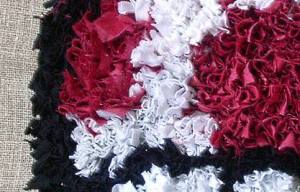 The language of rugs in northern England
reminds us how much regional variation there was in all domestic crafts and chores.
Proddy, proggy, clippy, stobby, peggy are a few of the names used in just one part
of Britain to describe near-identical methods of rug-making. Clippings from old
clothes, or remnants from textile factories, were pushed one by one through a piece
of cheaply-produced, loosely-woven canvas, using a peg or whatever was easily available
locally.
The language of rugs in northern England
reminds us how much regional variation there was in all domestic crafts and chores.
Proddy, proggy, clippy, stobby, peggy are a few of the names used in just one part
of Britain to describe near-identical methods of rug-making. Clippings from old
clothes, or remnants from textile factories, were pushed one by one through a piece
of cheaply-produced, loosely-woven canvas, using a peg or whatever was easily available
locally.
Cheap jute sacking, including American feedsacks and British potato sacks, made it easy to create certain kinds of rag rug at almost no cost. No longer did weavers have to be paid, warp yarn bought, or linen backing cloth paid for. In America rag strips were mostly threaded through gaps in the sacking from the upper side, producing hooked rag rugs. Meanwhile in England there were hooky mats with individual scraps pulled through the backing from above, and a range of peg rugs, proddy mats etc. with scraps prodded through with the rug upside down, often while stretched on a simple wooden frame. (See picture below right.)
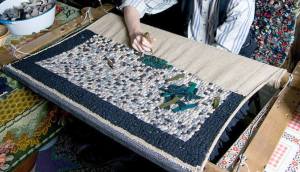 Rugs made of cloth would generally
stand up to being washed in a tub if they were small enough. Bigger ones could be
rinsed through in a creek or stream. In Finland and
Sweden there is a tradition of washing
rag rugs in summer in the nearest lake or river. Some Finnish women used to freshen
their rugs at the end of winter by spreading them out on snow, sprinkling more
snow on
top, then hanging them to dry in sunshine and/or breeze. This continued in some
areas until the 1960s.
Rugs made of cloth would generally
stand up to being washed in a tub if they were small enough. Bigger ones could be
rinsed through in a creek or stream. In Finland and
Sweden there is a tradition of washing
rag rugs in summer in the nearest lake or river. Some Finnish women used to freshen
their rugs at the end of winter by spreading them out on snow, sprinkling more
snow on
top, then hanging them to dry in sunshine and/or breeze. This continued in some
areas until the 1960s.
Other pages on this site related to textiles include:
Marseilles and Marcella quilts and coverlets
Knitting sheaths and belts
Medieval and Renaissance beds, and
fabrics for hangings, covers, sheeting etc.
Ironing frills and ruffles
Country Rag Crafts
from Amazon.com
or Amazon UK
Pages about rag rugs from the past:
Rag rugs from UK fishing communities
Photo of elderly lady knitting rag rug
in early 20th century Massachusetts
1940s rag rug making in England
19th century rag rug "boom"
1946
article from Detroit on weaving rag rugs (pdf)
This is a good opportunity to repeat the thanks on the acknowledgements page to all the photographers who have licensed their work for re-use. The illustrations here add so much to the page, and in many cases they show the photographer's own craftwork.
 17 March 2009
17 March 2009
You may like our new sister site Home Things Past where you'll find articles about antiques, vintage kitchen stuff, crafts, and other things to do with home life in the past. There's space for comments and discussion too. Please do take a look and add your thoughts. (Comments don't appear instantly.)
For sources please refer to the books page, and/or the excerpts quoted on the pages of this website, and note that many links lead to museum sites. Feel free to ask if you're looking for a specific reference - feedback is always welcome anyway. Unfortunately, it's not possible to help you with queries about prices or valuation.


